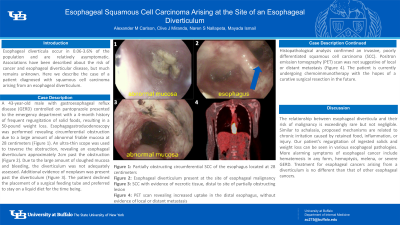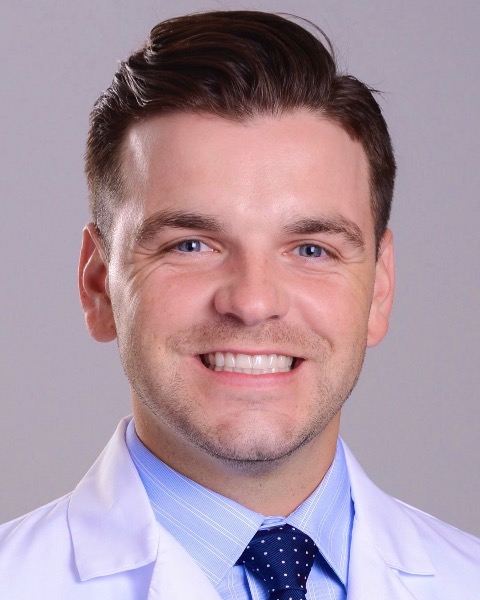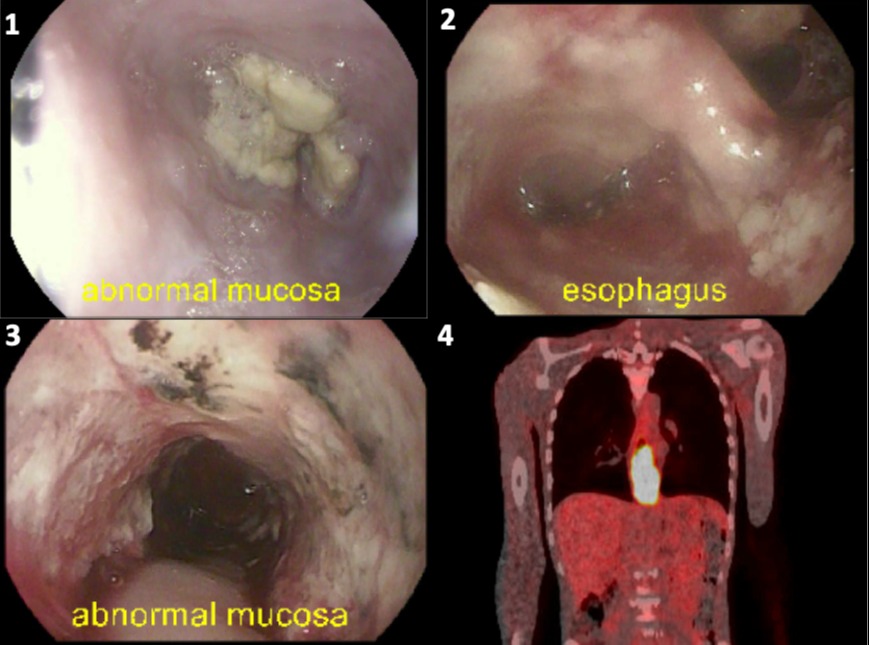Monday Poster Session
Category: Esophagus
P1888 - Esophageal Squamous Cell Carcinoma Arising at the Site of an Esophageal Diverticulum
Monday, October 23, 2023
10:30 AM - 4:15 PM PT
Location: Exhibit Hall

Has Audio

Alexander M. Carlson, DO
University at Buffalo
Buffalo, NY
Presenting Author(s)
Alexander M. Carlson, DO, Clive J. Miranda, DO, MS, Naren S. Nallapeta, MBBS, Mayada Ismail, MD
University at Buffalo, Buffalo, NY
Introduction: Esophageal diverticula occur in 0.06-3.6% of the population and are relatively asymptomatic. Associations have been described about the risk of cancer and esophageal diverticular disease, but much remains unknown. Here we describe the case of a patient diagnosed with squamous cell carcinoma arising from an esophageal diverticulum.
Case Description/Methods: A 43-year-old male with gastroesophageal reflux disease (GERD) controlled on pantoprazole presented to the emergency department with a 4-month history of frequent regurgitation of solid foods, resulting in a 50-pound weight loss. Esophagogastroduodenoscopy was performed revealing circumferential obstruction due to a large amount of abnormal friable mucosa at 28 centimeters (Figure 1). An ultra-thin scope was used to traverse the obstruction, revealing an esophageal diverticulum approximately 2cm past the obstruction (Figure 2). Due to the large amount of sloughed mucosa and bleeding, the diverticulum was not adequately assessed. Additional evidence of neoplasm was present past the diverticulum (Figure 3). The patient declined the placement of a surgical feeding tube and preferred to stay on a liquid diet for the time being. Histopathological analysis confirmed an invasive, poorly differentiated squamous cell carcinoma (SCC). Positron emission tomography (PET) scan was not suggestive of local or distant metastasis (Figure 4). The patient is currently undergoing chemoimmunotherapy with the hopes of a curative surgical resection in the future.
Discussion: The relationship between esophageal diverticula and their risk of malignancy is exceedingly rare but not negligible. Similar to achalasia, proposed mechanisms are related to chronic irritation caused by retained food, inflammation, or injury. Our patient’s regurgitation of ingested solids and weight loss can be seen in various esophageal pathologies. More alarming symptoms of esophageal cancer include hematemesis in any form, hemoptysis, melena, or severe GERD. Treatment for esophageal cancers arising from a diverticulum is no different than that of other esophageal cancers.
In summary, we present a unique case of an esophageal squamous cell carcinoma arising at the site of a diverticulum. Routine cancer surveillance is not recommended in patients with an esophageal diverticulum due to sporadic evidence of its association with malignant transformation. Some providers, however, deem that endoscopic evaluation every 3 years in conjunction with symptom surveillance is a reasonable approach.

Disclosures:
Alexander M. Carlson, DO, Clive J. Miranda, DO, MS, Naren S. Nallapeta, MBBS, Mayada Ismail, MD. P1888 - Esophageal Squamous Cell Carcinoma Arising at the Site of an Esophageal Diverticulum, ACG 2023 Annual Scientific Meeting Abstracts. Vancouver, BC, Canada: American College of Gastroenterology.
University at Buffalo, Buffalo, NY
Introduction: Esophageal diverticula occur in 0.06-3.6% of the population and are relatively asymptomatic. Associations have been described about the risk of cancer and esophageal diverticular disease, but much remains unknown. Here we describe the case of a patient diagnosed with squamous cell carcinoma arising from an esophageal diverticulum.
Case Description/Methods: A 43-year-old male with gastroesophageal reflux disease (GERD) controlled on pantoprazole presented to the emergency department with a 4-month history of frequent regurgitation of solid foods, resulting in a 50-pound weight loss. Esophagogastroduodenoscopy was performed revealing circumferential obstruction due to a large amount of abnormal friable mucosa at 28 centimeters (Figure 1). An ultra-thin scope was used to traverse the obstruction, revealing an esophageal diverticulum approximately 2cm past the obstruction (Figure 2). Due to the large amount of sloughed mucosa and bleeding, the diverticulum was not adequately assessed. Additional evidence of neoplasm was present past the diverticulum (Figure 3). The patient declined the placement of a surgical feeding tube and preferred to stay on a liquid diet for the time being. Histopathological analysis confirmed an invasive, poorly differentiated squamous cell carcinoma (SCC). Positron emission tomography (PET) scan was not suggestive of local or distant metastasis (Figure 4). The patient is currently undergoing chemoimmunotherapy with the hopes of a curative surgical resection in the future.
Discussion: The relationship between esophageal diverticula and their risk of malignancy is exceedingly rare but not negligible. Similar to achalasia, proposed mechanisms are related to chronic irritation caused by retained food, inflammation, or injury. Our patient’s regurgitation of ingested solids and weight loss can be seen in various esophageal pathologies. More alarming symptoms of esophageal cancer include hematemesis in any form, hemoptysis, melena, or severe GERD. Treatment for esophageal cancers arising from a diverticulum is no different than that of other esophageal cancers.
In summary, we present a unique case of an esophageal squamous cell carcinoma arising at the site of a diverticulum. Routine cancer surveillance is not recommended in patients with an esophageal diverticulum due to sporadic evidence of its association with malignant transformation. Some providers, however, deem that endoscopic evaluation every 3 years in conjunction with symptom surveillance is a reasonable approach.

Figure: Figure 1: Partially obstructing circumferential SCC of the esophagus located at 28 centimeters
Figure 2: Esophageal diverticulum present at the site of esophageal malignancy
Figure 3: SCC with evidence of necrotic tissue, distal to site of partially obstructing lesion
Figure 4: PET scan revealing increased uptake in the distal esophagus, without evidence of local or distant metastasis
Figure 2: Esophageal diverticulum present at the site of esophageal malignancy
Figure 3: SCC with evidence of necrotic tissue, distal to site of partially obstructing lesion
Figure 4: PET scan revealing increased uptake in the distal esophagus, without evidence of local or distant metastasis
Disclosures:
Alexander Carlson indicated no relevant financial relationships.
Clive Miranda indicated no relevant financial relationships.
Naren Nallapeta indicated no relevant financial relationships.
Mayada Ismail indicated no relevant financial relationships.
Alexander M. Carlson, DO, Clive J. Miranda, DO, MS, Naren S. Nallapeta, MBBS, Mayada Ismail, MD. P1888 - Esophageal Squamous Cell Carcinoma Arising at the Site of an Esophageal Diverticulum, ACG 2023 Annual Scientific Meeting Abstracts. Vancouver, BC, Canada: American College of Gastroenterology.
